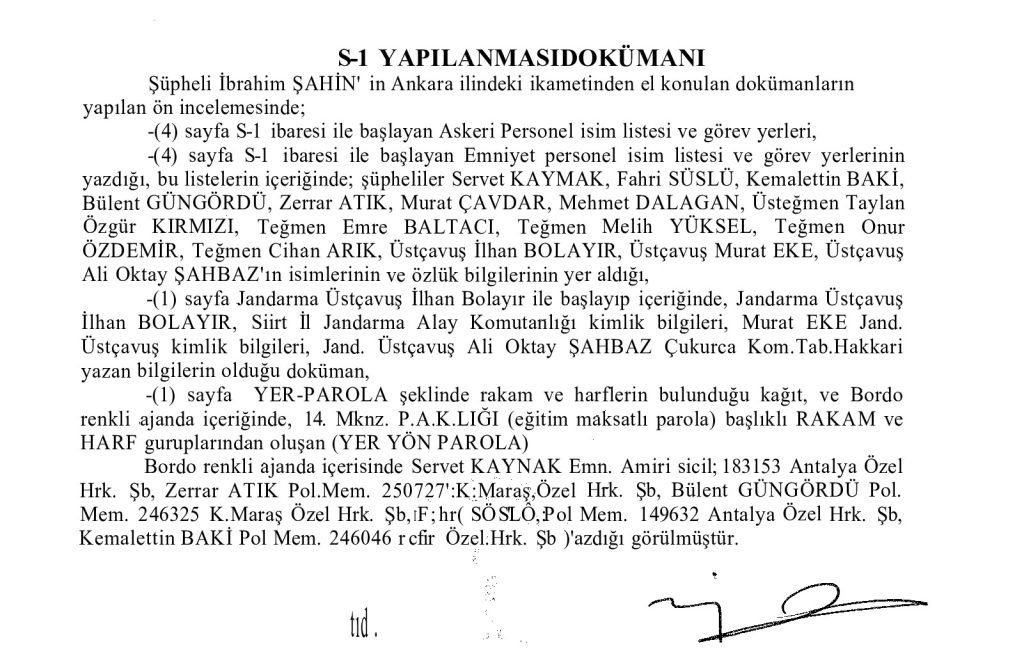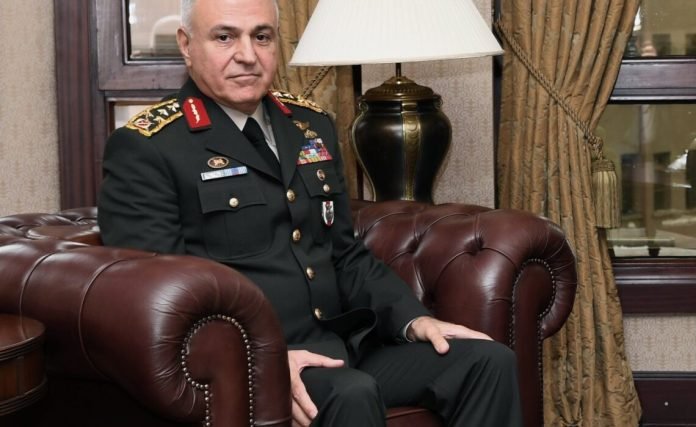Metin Gürak, recently appointed Turkey’s chief of general staff, has been accused of clandestinely forming an assassination squad to carry out attacks and murders targeting minority groups, especially non-Muslims, all under the guise of counterterrorism efforts, Nordic Monitor reported.
A trove of evidence shedding light on the existence of this covert squad has emerged from an extensive review of hundreds of legal documents by Abdullah Bozkurt of Nordic Monitor. These documents reveal a disturbing picture of Turkey’s top commander, who is alleged to have exceeded his mandate, violated laws and acted as a rogue general.
A shocking disclosure regarding Gürak’s covert hit squad was brought to light by İbrahim Şahin, the former deputy chief of the police department special operations unit. Şahin is a notorious figure who was convicted of involvement in extrajudicial killings during his time at the police department in the late 1990s.
Arrested in January 2009, Şahin provided a comprehensive account of his interactions with Gürak to the public prosecutor and later testified in court, revealing how he was secretly meeting with Gürak when the general was head of the General Staff communications department.
During that period, Gürak was engaged in orchestrating a covert psychological and influence operation (PSYOP) that entailed the establishment of numerous disinformation websites in Turkey, primarily focused on conducting negative campaigns against the United States, the European Union and the Jewish and Christian communities as well as various minority groups.
In his testimony Şahin revealed that he had been summoned by Gürak, who instructed him to assemble a select group of 150 to 300 individuals, covertly designated as the “S-1 team.” This team’s intended purpose was to operate as a clandestine death squad, responsible for carrying out assassinations, bombings and other violent attacks.
Secret S-1 team structure as obtained from the suspect’s residence in Ankara:

The intended targets of this operation included individuals from minority non-Muslim communities and others perceived as threats within Turkey. During questioning by the prosecutor, Şahin disclosed that he was on the verge of executing operations against Armenians under orders from the General Staff had he not been apprehended by the police.
Şahin further revealed that he had maintained consistent communication with Gen. Gürak, keeping him apprised of developments within the S-1 team. Gürak had instructed him to recruit individuals exclusively of a Turkish ethnic background for a group tasked with what was euphemistically referred to as “domestic cleansing” operations within Turkey.
Members of the S-1 team were recruited from both the ranks of both the military and the police. Substantial evidence, including wiretaps, seized documents and the discovery of arms, strongly indicated that the group’s plans were already underway. The assassination plots had been meticulously prepared, with detailed preliminary work such as surveillance photographs, building layouts and assignment orders for those tasked with carrying out the attacks.
Among the documents seized from Şahin’s apartments in Istanbul and Ankara were intricate assassination plots targeting prominent figures, including the then-Armenian Patriarch Mesrob Mutafyan and president of the Alevi Bektaşi Federation at the time Ali Balkız, as well as the federation’s secretary-general, Kazım Genç, and the leader of Sivas’ Armenian community, Minas Durmaz Güler.
In his extensive 107-page testimony to the public prosecutor, Şahin disclosed that during his meeting with Gürak, he was informed by the general that the entire scheme had received approval from then-Chief of General Staff Gen. İlker Başbuğ. Başbuğ was subsequently indicted on multiple charges. Notably, both Gürak and Başbuğ shared family ties, and Başbuğ played a pivotal role in facilitating Gürak’s rapid promotion through the ranks, elevating him from colonel to brigadier general shortly after assuming the position of chief of general staff.
According to Şahin’s testimony, had he not been apprehended, a military ceremony was scheduled for him on January 12, 2009, at General Staff headquarters to celebrate his new role as head of the S-1 team. He had even prepared a speech for the ceremony in which he intended to express gratitude to Chief of General Staff Başbuğ for the covert assignment.
A substantial cache of weaponry, ammunition and explosives, including C-3 and C-4 plastic explosives, was uncovered buried in Ankara’s Gölbaşı district. This discovery followed a police search initiated based on a map found in Şahin’s residence on January 9, 2009. Şahin admitted to orchestrating the secret S-1 structure and collecting intelligence on Armenians in Turkey. However, he denied any involvement in planned assassinations targeting Alevis.
One report, compiled by the Army Academy, provided an analysis of Turkish-French relations and potential future developments. In addition, a separate 42-page report conducted a review of France’s domestic intelligence organization, the Directorate of Territorial Security (DST).
The books, reports and documents collected by Şahin offer insight into his anti-Semitic, far-right nationalist beliefs. Among them, a four-page document found in his residence bore the title “Jewish Blood in a Muslim Cemetery.” Additionally, one document delved into the perceived alliance between Kurds and Israel.
Yet another document explored Zionist conspiracy theories related to global dominance. This document asserted that Zionists intentionally hindered agricultural progress in developing nations to perpetuate Jewish control over the world. It further claimed that this strategy had been effective in Turkey. According to the document, an Ottoman secret police group known as the Special Organization (Teşkilat-ı Mahsusa), which was under the influence of far-right nationalist ruling party the Committee of Union and Progress (CUP) in 1915, intercepted this information from Zionists.
Şahin and his associates conducted investigations into various people and entities, suspecting them of having malicious intentions. These included the Greek Orthodox Patriarchate and Patriarch Bartholomew, George Marovitch, the former Istanbul representative of the Vatican, retired Assyrian Catholic Bishop Yusuf Sağ, Turkish Muslim cleric Fethullah Gülen and organizations receiving funding from the European Union.
Among the confiscated materials, numerous handwritten and typed notes contained comprehensive instructions on how to construct improvised explosive devices (IEDs) using a range of materials, including ammonium nitrate and aluminum powder. These documents also provided information on where the necessary supplies could be procured in Turkey. These notes were categorized under the title of “sabotage” by Şahin.
The assassination plans were meticulously detailed and recorded in handwritten documents. For instance, the plan for a vehicle bombing targeting Balkız included not only the home and business addresses of the target but also detailed building layouts. The documents contained the name of the cell leader responsible for carrying out the attack, the identities of other accomplices involved in aiding and abetting the execution of the plan, the method for rigging a stolen vehicle with explosives, the acquisition of burner phones and even information on the target’s daily routine.
Likewise, another assassination plan targeting Armenian Patriarch Mutafyan included intricate details such as a map of the location of the Patriarchate, situated in Istanbul’s Eminönu district, as well as photographs of the patriarch. In this particular case, the attack was planned to involve an anti-tank portable weapon (LAW), and the responsibility for the operation was assigned to a cell operating within that district, led by Kenan Temur, a police officer in the S-1 unit. The plan was structured with five distinct stages, each accompanied by various coded messages that were handwritten as notes on documents.
The plot against Genç featured similar details, including the layout of his residence, photographs, contingency plans in the event of failure, escape routes and other critical information discovered among Şahin’s seized documents. Notably, the document said that the objective of the attack was to incite Alevis and foment discord between the Sunni and Alevi communities.
Among the documents, which contained the detailed assassination plots, police also discovered a map with hand-made markings pinpointing the location of the Russian Embassy in Ankara. It remains unclear why the suspects had identified the embassy on the map or whether there were any plans to target its employees in addition to the other plots.
Another plot involved a planned attack on the Eryaman shopping mall in the Turkish capital. Preparatory notes, surveillance photographs and the layout of the mall were among the documents seized, providing detailed information regarding this scheme.
Despite previous indictments and convictions on multiple charges, including murder, Şahin managed to secure his release from prison with influential support given to him by senior Turkish government leaders. One of his convictions stemmed from a trial related to the Susurluk affair in 1996, which unveiled illicit alliances between the criminal underworld, the police and the political establishment following a car crash in the town of Susurluk.
Additionally, he faced charges for ordering four assassinations targeting Kurdish businessmen in the 1990s. In 2002 he received a six-year prison sentence but was granted early release just a year later through a special amnesty extended to him by then-president Ahmet Necdet Sezer.
In August 2013 Şahin was handed down a sentence of 49 years, four months for his role in orchestrating the illegal S-1 team and planning a series of assassinations. Then chief of general staff Başbuğ, who had ordered the establishment of the S-1 team and approved the assassinations, received a life sentence, while Cengiz, Şahin’s accomplice, was sentenced to 11 years.
However, yet again, Şahin and the others found themselves escaping criminal penalties due to the intervention of President Recep Tayyip Erdogan. The case was ultimately overturned after political interference, and all the suspects, including Şahin, were released without facing legal consequences, in March 2014.
With his appointment of Gürak as chief of general staff on August 4, 2023, President Erdogan effectively signaled his endorsement of the general’s anti-Semitic and anti-Christian views. This move raised concerns as it disregarded Gürak’s involvement with Şahin in murder plots and a clandestine campaign against non-Muslim communities in Turkey.















